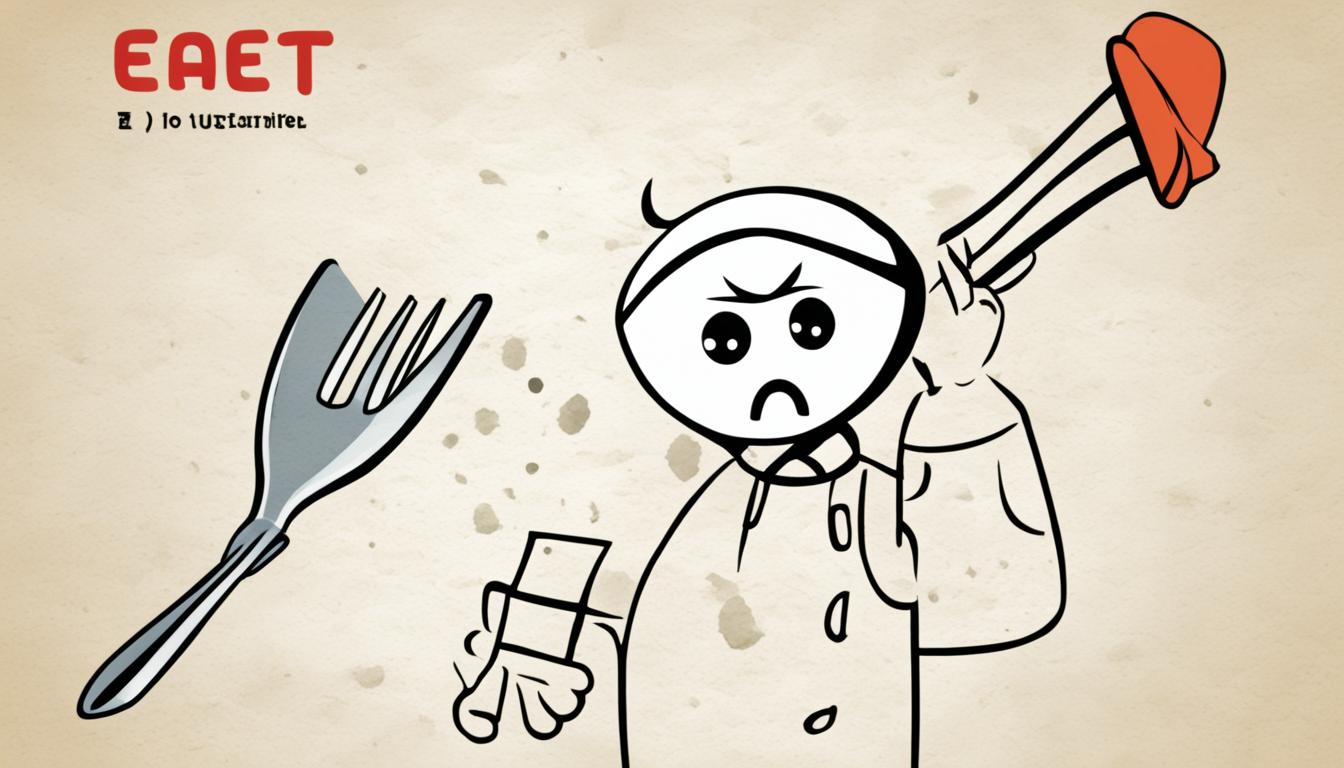Welcome to our guide on how to say “eat” in Japanese. In this article, we will explore the Japanese word for eat, provide guidance on how to pronounce it correctly, and offer equivalent words and phrases. By the end of this article, you’ll be equipped with the knowledge to confidently speak and write ‘eat’ in Japanese.
In Japanese, the word for “eat” is 食べる (taberu). It is a versatile verb that can be used in various contexts to indicate the act of eating. The pronunciation of 食べる is ta-be-ru, with each syllable pronounced separately.
Here are some equivalent words and phrases related to eating in Japanese:
- I’m eating: 食べています (tabete imasu)
- Let’s eat: 食べよう (tabeyou) or 食べましょう (tabemashou)
- Have a meal: 食事をする (shokuji o suru)
- Enjoy your meal: 召し上がれ (meshiagare)
When writing “eat” in Japanese, you can use the kanji character 食 followed by the hiragana character べる. The kanji character adds depth and cultural significance to the written word.
Understanding how to say “eat” in Japanese is not only about language but also about cultural usage. In Japan, mealtime is considered an important communal activity. It is customary to greet others before and after meals, saying “いただきます” (Itadakimasu) before eating and “ごちそうさま” (Gochisousama) after finishing a meal. These greetings convey gratitude and respect for the food and the act of eating.
Now that you have an overview of how to say eat in Japanese, let’s delve deeper into specific phrases and cultural nuances related to eating.
How to Say “Let’s Eat” in Japanese
When it comes to expressing the phrase “Let’s eat” in Japanese, there are two common ways to do so: “たべよう” (Tabeyou) and “たべましょう” (Tabemashou). Both of these phrases are derived from the verb “たべる” (Taberu), meaning “to eat,” and involve specific verb suffixes to convey the meaning of “let’s.”
The first expression, “たべよう,” is a casual form suitable for informal settings among friends, family, or close acquaintances. It has a warm and friendly connotation, allowing for a relaxed atmosphere during mealtime conversations.
On the other hand, “たべましょう” is a more formal form of “Let’s eat” in Japanese. This phrase is appropriate for professional settings, formal occasions, or when showing respect to someone of higher status. It maintains a polite tone, making it suitable for interacting with colleagues, business partners, or superiors.
To better understand how to use these expressions, let’s take a look at some examples:
| Casual Form | たべよう (Tabeyou) |
|---|---|
| Formal Form | たべましょう (Tabemashou) |
Now, here’s an example of using these phrases in context:
Example:
You are meeting a group of friends for dinner. You can use the casual form “たべよう” (Tabeyou) to enthusiastically invite everyone to start eating.
Japanese:
みんなでたべよう! (Minna de tabeyou!)
Translation:
Let’s eat together!
If you were in a formal setting, such as a business dinner, you would use the formal form “たべましょう” (Tabemashou) to suggest starting the meal politely.
Japanese:
みなさま、たべましょうませ (Minasama, tabemashou masе)
Translation:
Ladies and gentlemen, let’s eat.
Remember, the choice between the casual and formal form depends on the context and level of politeness required in the situation. By acquainting yourself with both expressions, you can confidently use them in the appropriate settings.
Throughout this article, you will discover various phrases and expressions related to eating in Japanese, providing you with a comprehensive understanding of how to navigate mealtime conversations with ease.
Japanese Greetings Before and After Eating
In Japanese culture, it is customary to exchange greetings before and after meals. These traditional mealtime greetings not only convey gratitude for the food but also show respect for the act of eating. Let’s explore two common Japanese greetings used before and after eating.
Japanese Greetings Before Eating
Before starting a meal in Japan, it is customary to say “いただきます” (Itadakimasu), which expresses gratitude for the food and the effort put into preparing it. This phrase acknowledges the interconnectedness of all living things and shows appreciation for the nourishment provided by the meal.
| Japanese | Transliteration | English Translation |
|---|---|---|
| いただきます | Itadakimasu | Let’s eat, I humbly receive |
By saying “いただきます” (Itadakimasu), you express gratitude for the food and show respect for the act of eating. It sets a positive tone for the meal and creates a sense of appreciation for the nourishment you are about to receive.
Japanese Greetings After Eating
After finishing a meal in Japan, it is common to say “ごちそうさま” (Gochisousama), which means “thank you for the meal” or “it was a feast.” This phrase expresses gratitude not only to the person who prepared the food but also to everyone who contributed to the meal, including the farmers, fishermen, and others involved in the production and distribution of the ingredients.
| Japanese | Transliteration | English Translation |
|---|---|---|
| ごちそうさま | Gochisousama | Thank you for the meal, It was a feast |
By saying “ごちそうさま” (Gochisousama) after a meal, you demonstrate your appreciation for the food and acknowledge the efforts made by others to provide you with a satisfying dining experience.
In conclusion, Japanese mealtime greetings such as “いただきます” (Itadakimasu) and “ごちそうさま” (Gochisousama) are deeply rooted in Japanese culture and reflect the values of gratitude and respect. By incorporating these greetings into your dining experiences, you can show appreciation for the food and the people involved in its production.
Variations of “Let’s Eat” in Japanese

In addition to the common expressions “たべよう” (Tabeyou) and “たべましょう” (Tabemashou), there are various ways to say “Let’s eat” in Japanese depending on the level of formality and the context of the situation. Understanding these variations will allow you to adapt your language to different social settings and engage in more natural conversations about eating in Japanese.
The informal form of “Let’s eat” in Japanese is “たべよう” (Tabeyou). This phrase is used among friends, family members, or in casual situations. It conveys a sense of familiarity and camaraderie. For example:
友達と一緒にたべよう。
(Tomodachi to issho ni tabeyou.)
Let’s eat together with friends.
The formal form of “Let’s eat” in Japanese is “たべましょう” (Tabemashou). This phrase is used in more formal settings or when addressing someone of higher social status. It demonstrates politeness and respect. For example:
お客様と一緒にたべましょう。
(Okyakusama to issho ni tabemashou.)
Let’s eat together with the guests.
Here is a table summarizing the informal and formal forms of “Let’s eat” in Japanese:
| Informal Form | Formal Form |
|---|---|
| たべよう (Tabeyou) | たべましょう (Tabemashou) |
By familiarizing yourself with these variations of “Let’s eat” in Japanese, you can confidently navigate different social situations in Japanese and enhance your language skills.
Using Particles in Japanese “Let’s Eat” Sentences
Japanese particles are essential elements in constructing sentences, including expressions related to “Let’s eat.” They provide crucial information about the relationship between words and clarify the roles of different elements within a sentence. In this section, we will explore the usage of three important particles in Japanese: を (wo), に (ni), and で (de).
The particle を (wo) is used to indicate the direct object of a verb. In the context of “Let’s eat,” を (wo) is added after the action verb “eat” to indicate the specific thing or food item that is being consumed. For example:
さあ、たべましょう。おすしをたべましょう。 (Saa, tabemashou. O sushi wo tabemashou.)
Now, let’s eat. Let’s eat sushi.
The particle に (ni) is used to indicate the target or destination of an action. In the context of “Let’s eat,” に (ni) is added after the verb to specify the place or location where the eating will take place. For example:
ちかくのレストランにいきましょう。たべましょう。 (Chikaku no resutoran ni ikimashou. Tabemashou.)
Let’s go to a nearby restaurant. Let’s eat.
The particle で (de) is used to indicate the means or method by which an action takes place. In the context of “Let’s eat,” で (de) is added after the verb to express the way or manner in which the eating will happen. For example:
みんなでレストランでたべましょう。 (Minna de resutoran de tabemashou.)
Let’s eat at the restaurant together.
By understanding the usage of particles を (wo), に (ni), and で (de) in “Let’s eat” sentences, you can convey specific information about the direct object, place, and method of eating. Using these particles correctly will enhance the clarity and precision of your Japanese language skills.
Related Phrases to “Let’s Eat” in Japanese
When it comes to mealtime conversations in Japanese, there are several related phrases that can enhance your dining experiences. In addition to the common expression “Let’s eat,” here are some other useful phrases to know:
1. Let’s Go to Eat
In Japanese, the phrase “Let’s go to eat” can be expressed as “食べに行こう” (Tabeni ikou). This phrase is often used when making plans to go out and enjoy a meal together. It signifies both the act of eating and spending time with others.
2. It’s Time to Eat
When you want to indicate that it’s time to eat, you can use the phrase “食べる時間です” (Taberu jikan desu). This is a straightforward way to let others know that the meal is ready to be enjoyed.
3. Please Eat
If you want to politely invite someone to eat, you can say “召し上がってください” (Meshiagatte kudasai). This phrase carries a sense of respect and hospitality, showing that you are inviting the person to partake in the meal.
4. Expressing How You Feel
In Japanese, you can use specific phrases to express how you feel about the food. For example:
| Phrase | Meaning | Usage |
|---|---|---|
| うまい (Umai) | Delicious | Used to express a positive reaction to the taste of the food. |
| お腹がすいた (Onaka ga suita) | I’m hungry | Used to express hunger or a desire to eat. |
| のどがかわいた (Nodo ga kawaita) | I’m thirsty | Used to express thirst or a desire to drink. |
By learning these related phrases, you will be able to engage in more natural and meaningful conversations about eating in Japanese. Whether you’re inviting others to eat, expressing your feelings about the food, or making plans to dine out, incorporating these phrases into your Japanese vocabulary will enhance your overall dining experience.
Summary and Conclusion
In this article, we have provided a comprehensive guide on how to say “eat” in Japanese. We started by covering the basic expressions for “Let’s eat” and their variations, both informal and formal. Through translations, examples, and explanations, you have learned how to pronounce and use these phrases accurately.
We also delved into Japanese mealtime greetings, exploring the significance and usage of the phrases “いただきます” (Itadakimasu) and “ごちそうさま” (Gochisousama). These greetings reflect the Japanese culture of expressing gratitude and respect towards food and eating.
Additionally, we introduced you to various related phrases, such as “Let’s go to eat,” “It’s time to eat,” and “Please eat.” These phrases allow for more nuanced and engaging conversations about food and dining.
By incorporating these phrases and expressions into your Japanese conversations, you will not only enhance your language skills but also deepen your cultural understanding. Practice using these phrases, and you will soon be able to navigate mealtime conversations with confidence. Congratulations on expanding your knowledge of how to say eat in Japanese!

